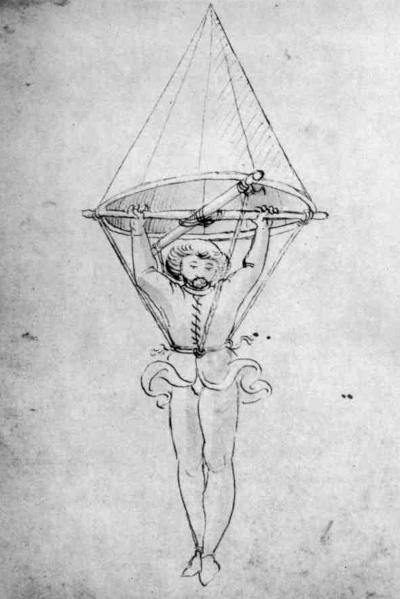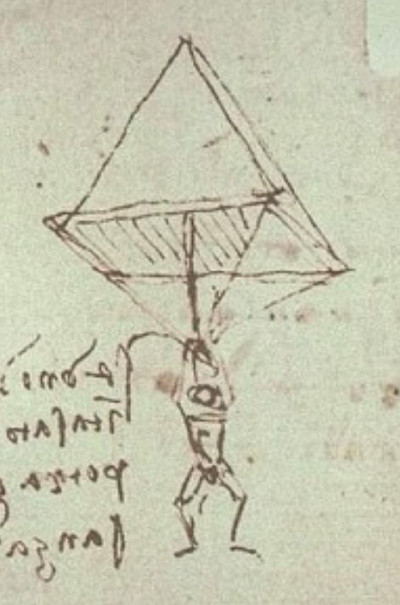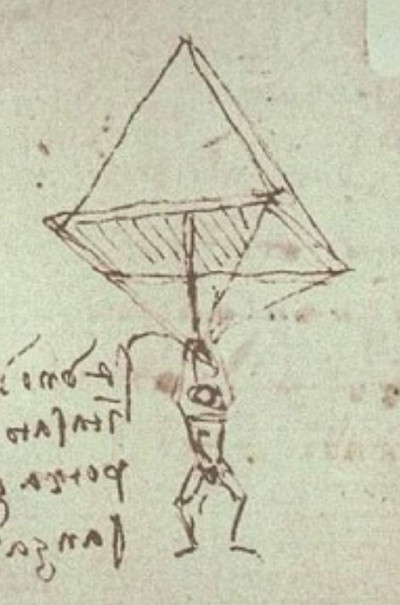Leonardo da Vinci was one of the first inventors to push the idea of a working parachute. His own designs have been proven effective in a test carried out in the UK in the year 2000.
Introduction
There are some examples of earlier designs bearing a similarity to modern-day parachutes, but Da Vinci was probably the first to produce something which feasibly could work. He implemented a greater complexity to his parachute than had been seen before and avoided some of the cruder solutions that had been put forward centuries earlier.
It was specifically the shape of the parachute which was unique to Da Vinci's design, at that time, with a more considered design in which a pyramidal or conical shape would function more effectively against air flow. Leonardo had studied the impact of wind and air upon flying birds earlier in his life and could translate many of his learnings into parachute technology.
Leonardo spent many years attempting to give humans the ability to fly, and it became something of an obsession. Despite his considerable commitments to other projects and disciplines across his career, including painting, drawing and the occasional sculpture, he was still able to produce hundreds of drawings and notes related to engineering. One of his main focuses was flight machines.
Da Vinci's ornithopter attempted to generate enough power for human flight, but the inventor quickly realised that this approach would not work. There was simply no way he could support the weight of a human using the wing-flapping technique of a bird, and so he sought other solutions.
Eventually, the Renaissance master realised that working with air flow and the gravitational pull, rather than against, was the way to go. He saw how birds could glide through the air with little effort. Parachutes, he believed, might offer the opportunity to float people through the air, and if large enough, this could be done safely.
Some of Da Vinci's initial interest may have been related to military concerns, and a desire to gain an advantage on the battlefield, due to his role as a military engineer for a number of years. Leonardo's instincts, though, were not about conflict, but more the opportunity to learn from nature in order to evolve humanity in a positive manner.
This article examines Da Vinci's parachute designs in full, discussing how likely they were to work, and placing them within the context of parachute inventions more generally. We also consider the other flying machines that he invented, and why he was unable to build and test any of them within his own lifetime.
Table of Contents
- Introduction
- Earliest Parachute Designs
- Inspiration from Theatre Production
- Design Studio in Milan
- Leonardo da Vinci's Parachute Design
- Successful Flight
- References
Earliest Parachute Designs
Prior to Da Vinci's pyramidal parachute structures, there were a few cruder alternatives. A number of European inventors understood the potential for a working parachute, through the control and adaptation of air flow. A Spanish man in the 9th century famously jumped from a tower with an enlarged coat in order to test his theory, which was perhaps taken from flying squireels or other animals.
There are also drawings from earlier in the Italian Renaissance of flat parachutes which might have come to the attention of Da Vinci. He himself, upon seeing them, would have known that they could not possibly have ever worked, but the mere idea may have been enough to set his own curiosities in motion.
Interestingly, the anonymously-attributed design from 1470 came only 15 years before Da Vinci's, raising the possibility that he either saw this design himself, or heard discussion of it amongst his regular meetings-of-minds with fellow artists and creatives. We will never know the answer to this mystery, but it does seem quite a coincidence.
 Early Anonymous Parachute Design from the Italian Renaissance, 1470s
Early Anonymous Parachute Design from the Italian Renaissance, 1470s
Inspiration from Theatre Production
Leonardo had become interested in flying machines, as well as flying creatures, from his time working in theatre production. Whilst serving as an apprentice he was tasked with creating a number of theatrical props which would replicate, in a crude, humorous manner, the workings of various birds. They would float across the stage and provide a scene of amuzement for the paying public.
The artist would eventually return to this scene of fiction in later life, once he realised that none of his designs would be effective. Despite that ultimate lack of success, there is still plenty of merit in his achievements, and his learnings of potential problems would aid later generations of engineers, making his contribution highly valuable.
Design Studio in Milan
Having been assigned a significant sculpture project, Leonardo was given spacious accomodation with which to plan and build a large horse monument. Whilst this sculpture would never be completed, he used these grounds to also play around with his engineering designs, such as flying machines and parachutes. This opportunity would eventually come to an end, but Leonardo used the period wisely, helping to evolve his thinking onwards once more.
This spell was whilst living in Milan and working for the Sforza family. He enjoyed a strong relationship with the Duke, and completed many projects in different disciplines for him. His flying machines could potentially bring advantages on the battlefield, and so were of interest to the Duke, whilst most other projects were purely for aesthetic, artistic value.
Leonardo da Vinci's Parachute Design
Leonardo da Vinci produced a drawing of a parachute design in around 1485. It is contained within the Codex Atlanticus publication, which is a collection of notes and sketches by the artist from between the years of 1478–1519. It is accompanied within this treasure trove of art by other inventions too, such as the catapault and various hydraulic discoveries.
His design, as shown below, was a relatively quick sketch, without the same precision or depth of planning found within many of his other engineering designs. Essentially, we see a man hanging from a flat, square structure, with strings meeting in the middle, from which he hangs. Above that is a tent-like design, allowing air be contained above the parachutist's head.
"...If a man has a structure made out of coated cloth 12 arms wide and 12 tall, he will be able to throw himself from any great height without hurting himself..."
The artist wrote within his notes that the intention for this parachute was to allow humans to jump from great heights without any fear of injury. The inventor was too busy working on other ideas to develop his parachute, and so the design would go untested within his own lifetime. As with many of his inventions, the fundamental theories could have worked, when combined with modern materials and discoveries.
Leonardo is believed to have planned to construct his parachute using wooden beams which would create the base, with a large linen cloth being placed over the top. When air rushed through, the parachute shape would be formed, and the passenger's descent would naturally slow to a safer speed. Modern parachutes prefer a rounded design, where as Leonardo went for a tent-like, or pyramidal shape instead.
Experts have since evaluated his ideas, based on his notes and drawing from 1485 and concluded that several tweaks would be required in order to make it work effectively. Anyone testing this out for real at the time, in their opinion, would almost certainly have experienced serious injury. The biggest draw back, as with many of his inventions, would have been the heavy weight of the materials used at that time to build it.
Successful Flight
In the year 2000 a British parachutist successfully built and tested Da Vinci's original design for the first time. He sensibly had a conventional parachute on-hand for the final descent, having been advised against the project by experts. He recalled later that the journey had been entirely pleasurable, and that Da Vinci's version provided a slower descent, because of its alternative shape.
The parachutist had been unable to get permission to fly in the UK, before of the perceived danger of this experiment, and so was forced to carry out the test in Africa. A number of other models have been produced around the world, based on Da Vinci's designs, but these have not been tested as yet, as far as we can tell.
There have been a number of cases within the 20th and 21st century in which Da Vinci's designs have been adapted and testing successfully by enthusiasts. These projects have helped to bring a greater validility to Da Vinci's studies, as for many years he was only considered a painter, with most other work ignored. In the present day, however, he is considered a rounded polymath, with many skills across a wide variety of disciplines.
References
- Leonardo. The Complete Paintings and Drawings, Frank Zöllner & Johannes Nathan, Taschen
- Leonardo da Vinci, Walter Isaacson





